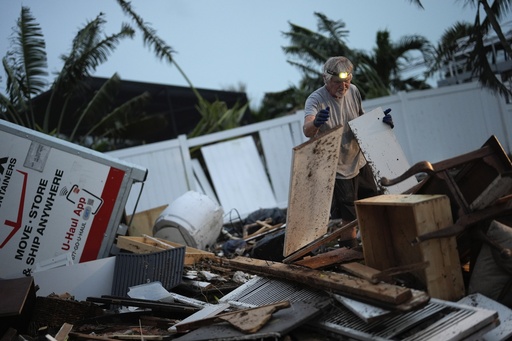
Federal disaster assistance is prevalent across the United States, with approximately 94% of Americans residing in counties that have received support from the Federal Emergency Management Agency (FEMA) since 2011.
However, the political dynamics surrounding disaster relief have recently shifted, becoming contentious after Hurricane Helene last year and the wildfires in California this year.
President Trump, along with a conservative think tank, has suggested the prospect of reallocating disaster response responsibilities to the states, which may include reducing the role of FEMA or cutting federal financial assistance.
Experts within the field express significant concerns regarding this potential shift.
Craig Fugate, who has served as an emergency manager in Florida and directed FEMA under President Obama, argues that most states, including Florida, lack the financial resources and infrastructure to manage large-scale disasters without substantial federal aid.
Susan Cutter, leading the Hazards Vulnerability & Resilience Institute at the University of South Carolina, echoes this sentiment, pointing out that states would struggle to cope with disasters on their own and would greatly suffer without federal assistance.
Data from New York University’s Rebuild by Design indicates that virtually every state has received federal disaster assistance since 2011, with every state facing climate-related challenges regardless of their political affiliation.
Amy Chester, director of Rebuild by Design, emphasizes that climate challenges do not discriminate along party lines; communities are impacted across both red and blue states.
Since 2011, FEMA has allocated over $68.2 billion in aid for a range of disasters, excluding incidents related to the pandemic or oil spills. This figure only accounts for government assistance and not individual aid, with tens of billions more provided through the Department of Housing and Urban Development to help citizens recover and rebuild.
An analysis of the data reveals that states governed by Republicans tend to receive slightly more FEMA funding per capita compared to their Democratic counterparts.
On average, states with Republican governors have received around $222 per person in FEMA aid since 2011, while states led by Democrats average $193 across their disaster declarations.
Swing states that voted for both Trump and Biden, which have mixed party representation in the U.S. Senate, receive substantially less FEMA funding, averaging just $35 per person despite comprising a considerable portion of the country’s population.
It appears that Republican states, accounting for 42.7% of the U.S. population, experience 56.6% of federally declared disasters, yet receive only half of the FEMA funding. In comparison, blue states, which represent 42.2% of the population and face 35.8% of the disasters, receive nearly half of FEMA’s financial aid.
Notably, the majority of the states that frequently solicit assistance from FEMA—termed “frequent fliers” by Fugate—are led by Republican officials. Among the top states for FEMA funding and disaster declarations are Florida, Louisiana, Alaska, Tennessee, Oklahoma, and Mississippi.
Moreover, a significant portion of congressional districts that have recorded multiple federally declared disasters since 2011 is represented by Republicans.
In fact, three-quarters of these districts can be found in states like Kentucky, Louisiana, New Hampshire, Oklahoma, Texas, Vermont, and West Virginia.
According to Cutter, disaster response has become less political than it was decades ago, but the current system requires states to request presidential disaster declarations for financial aid to flow.
Typically, the federal government covers 75% of disaster costs, with states and locals responsible for the remaining 25%. However, in extreme situations, the state’s contribution can decrease to as low as 10% if Congress intervenes.
The rapid accumulation of costs during a disaster can overwhelm state budgets, often impacting payroll capabilities, casting FEMA in a crucial role by providing initial funds quickly—sometimes within 30 days.
FEMA’s specialized expertise is highlighted in its ability to tackle unique challenges, such as the large-scale debris cleanup needed after California’s wildfires. Fugate noted that FEMA can deploy teams like the U.S. Army Corps of Engineers, known for their efficiency in clearing disaster debris, which can result in faster recovery and savings for taxpayers.
Concerns also arise over the potential for increased waste, fraud, and abuse if disaster assistance responsibilities shift predominantly to states, as federal procurement laws currently help to mitigate these issues.
Fugate recalls the vital support provided post-Hurricane Charley in 2004, pointing out that it was federal assistance that allowed the state to rebuild essential services like fire departments and schools, asserting that the state could not have accomplished this alone.

